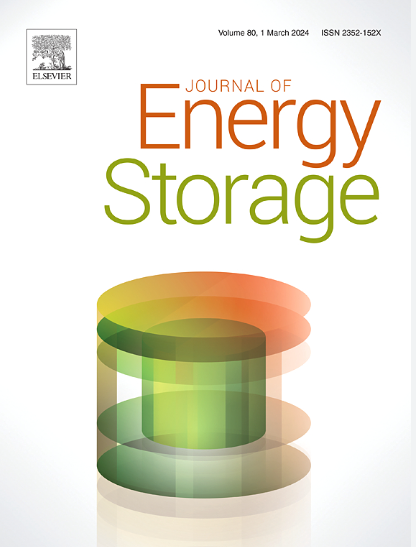Fabrication of MXene/reduced graphene oxide/MoO3 film electrode for flexible supercapacitors
IF 8.9
2区 工程技术
Q1 ENERGY & FUELS
引用次数: 0
Abstract
MXene nanosheets exhibit a tendency to agglomerate in electrochemical processes, significantly impairing the electrochemical performance and diminishes their practical applicability. However, this problem can be effectively suppressed by introducing functional intercalation materials. Herein, MXene/reduced graphene oxide (rGO)/MoO3 films synthesized utilizing a vacuum-assisted filtration technique. MoO3 nanofibers and rGO nanosheets serve as essential intercalation materials, establishing a highly stable interlayer configuration within MXene nanosheets. This arrangement significantly increases the spacing between the MXene layers, thereby facilitating the development of a multidimensional and efficient ion transport pathway and exposing more active sites. Under the synergistic effect of this composite structure, the film exhibited a specific capacitance of 854.2 F g−1 at 1 A g−1. In addition, an asymmetric supercapacitor (ASC) assembled with MXene/rGO/MoO3 film as the positive electrode and activated carbon (AC) as the negative electrode shows a wide voltage window of 1.6 V and achieves a high energy density of 54 Wh kg−1 at a power density of 800 W kg−1. More importantly, at 3 A g−1, this ASC maintained 85.4 % capacitance retention after 14,000 cycles, demonstrating excellent cycling stability. The optimization strategy for the MXene/rGO/MoO3 electrode not only illustrates the technological progress of MXene within the domain of energy storage but also establishes a robust technological framework and theoretical underpinning for its utilization in flexible energy storage devices.
柔性超级电容器用MXene/还原氧化石墨烯/MoO3薄膜电极的制备
MXene纳米片在电化学过程中有结块的倾向,严重影响了其电化学性能,降低了其实际应用。然而,通过引入功能嵌入材料可以有效地抑制这一问题。本文利用真空辅助过滤技术合成了MXene/还原氧化石墨烯(rGO)/MoO3薄膜。MoO3纳米纤维和氧化石墨烯纳米片是必不可少的嵌入材料,在MXene纳米片中建立了高度稳定的层间结构。这种排列显著增加了MXene层之间的间距,从而促进了多维高效离子传输途径的发展,并暴露了更多的活性位点。在这种复合结构的协同作用下,薄膜在1 a g−1时的比电容为854.2 F g−1。此外,以MXene/rGO/MoO3薄膜为正极,活性炭(AC)为负极组装的非对称超级电容器(ASC)具有1.6 V的宽电压窗,在800 W kg - 1的功率密度下可获得54 Wh kg - 1的高能量密度。更重要的是,在3a g−1下,这种ASC在14000次循环后保持了85.4%的电容保持率,表现出优异的循环稳定性。MXene/rGO/MoO3电极的优化策略不仅说明了MXene在储能领域的技术进步,而且为其在柔性储能器件中的应用奠定了坚实的技术框架和理论基础。
本文章由计算机程序翻译,如有差异,请以英文原文为准。
求助全文
约1分钟内获得全文
求助全文
来源期刊

Journal of energy storage
Energy-Renewable Energy, Sustainability and the Environment
CiteScore
11.80
自引率
24.50%
发文量
2262
审稿时长
69 days
期刊介绍:
Journal of energy storage focusses on all aspects of energy storage, in particular systems integration, electric grid integration, modelling and analysis, novel energy storage technologies, sizing and management strategies, business models for operation of storage systems and energy storage developments worldwide.
 求助内容:
求助内容: 应助结果提醒方式:
应助结果提醒方式:


